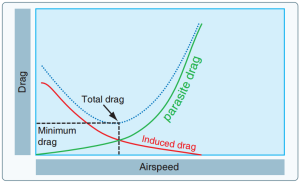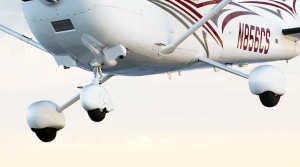Drag as it relates to aerodynamics in aviation is just one of those things that must be dealt with and overcome – literally overcome. When we talk about drag in aviation it is usually discussed in relation to one of the four forces: lift, weight, thrust, and drag. It is the force that acts opposite to thrust, or opposite the direction of the aircraft flightpath. Aerodynamics for Aviators defines drag as the force that retards forward motion of an aircraft through the air. Drag as an aerodynamic parameter can be broken down into two basic types, parasite drag and induced drag.
Parasite Drag is the more complicated of the two and includes all the forces that work to slow an aircraft’s movement. It’s the difference between throwing a square object through the air compared to a circular object. Which of the two would generate a higher parasite drag? If you said the square object you would be correct. Simply put parasite drag is caused by the friction of air moving over the surface of the aircraft, or the displacement of air by the aircraft. There are many types of parasite drag; however, in aviation we typically discuss the three most common: form drag, interference drag, and skin friction drag. The Pilot’s Handbook of Aeronautical Knowledge (FAA-H-8083-25) does a great job at describing these.
- Form drag is the portion of parasite drag generated by the aircraft due to its shape and airflow around it. Examples include the engine cowlings, antennas, and the aerodynamic shape of other components. When the air has to separate to move around a moving aircraft and its components, it eventually rejoins after passing the body. How quickly and smoothly it rejoins is representative of the resistance that it creates, which requires additional force to overcome. Form drag is the easiest to reduce when designing an aircraft. The solution is to streamline as many of the parts as possible.
- Interference drag comes from the intersection of airstreams that creates eddy currents, turbulence, or restricts smooth airflow. For example, the intersection of the wing and the fuselage at the wing root has significant interference drag. Air flowing around the fuselage collides with air flowing over the wing, merging into a current of air different from the two original currents. The most interference drag is observed when two surfaces meet at perpendicular angles. Fairings are used to reduce this tendency. If a jet fighter carries two identical wing tanks, the overall drag is greater than the sum of the individual tanks because both of these create and generate interference drag. Fairings and distance between lifting surfaces and external components (such as radar antennas hung from wings) reduce interference drag.
- Skin friction drag is the aerodynamic resistance due to the contact of moving air with the surface of an aircraft. Every surface, no matter how apparently smooth, has a rough, ragged surface when viewed under a microscope. The air molecules, which come in direct contact with the surface of the wing, are virtually motionless. Each layer of molecules above the surface moves slightly faster until the molecules are moving at the velocity of the air moving around the aircraft. This speed is called the free-stream velocity. The area between the wing and the free-stream velocity level is about as wide as a playing card and is called the boundary layer. At the top of the boundary layer, the molecules increase velocity and move at the same speed as the molecules outside the boundary layer. The actual speed at which the molecules move depends upon the shape of the wing, the viscosity (stickiness) of the air through which the wing or airfoil is moving, and its compressibility (how much it can be compacted).
The airflow outside of the boundary layer reacts to the shape of the edge of the boundary layer just as it would to the physical surface of an object. The boundary layer gives any object an “effective” shape that is usually slightly different from the physical shape. The boundary layer may also separate from the body, thus creating an effective shape much different from the physical shape of the object. This change in the physical shape of the boundary layer causes a dramatic decrease in lift and an increase in drag. When this happens, the airfoil has stalled.
In order to reduce the effect of skin friction drag, aircraft designers utilize flush mount rivets and remove any irregularities that may protrude above the wing surface. In addition, a smooth and glossy finish aids in transition of air across the surface of the wing. Since dirt on an aircraft disrupts the free flow of air and increases drag, keep the surfaces of an aircraft clean and waxed.
Induced Drag in a sense is a little more straight forward. It is a byproduct of lift inversely proportional to the airspeed of the aircraft. As airspeed slows, a greater angle of attack is needed to create lift increasing the aircraft’s induced drag. When airspeed is increased, the wing is able to produce the same amount of lift at a shallower angle of attack decreasing the amount of induced drag. This type of drag is a result of wing circulation, high pressure below the wing moving to an area of lower pressure above the wing. You can learn more about wing circulation and induced drag in the second edition of Aerodynamics for Aviators.
The sum of parasite drag and induced drag is called total drag and is commonly expressed as shown in the figure below. Assuming constants like level flight, weight, configuration and altitude when plotted against velocity (airspeed), parasite drag increase while induced drag decreases with an increase in velocity.

What type of drag is associated with removing the wheel fairings from the landing gear of a Cessna 172? Let us know in the comments section.





